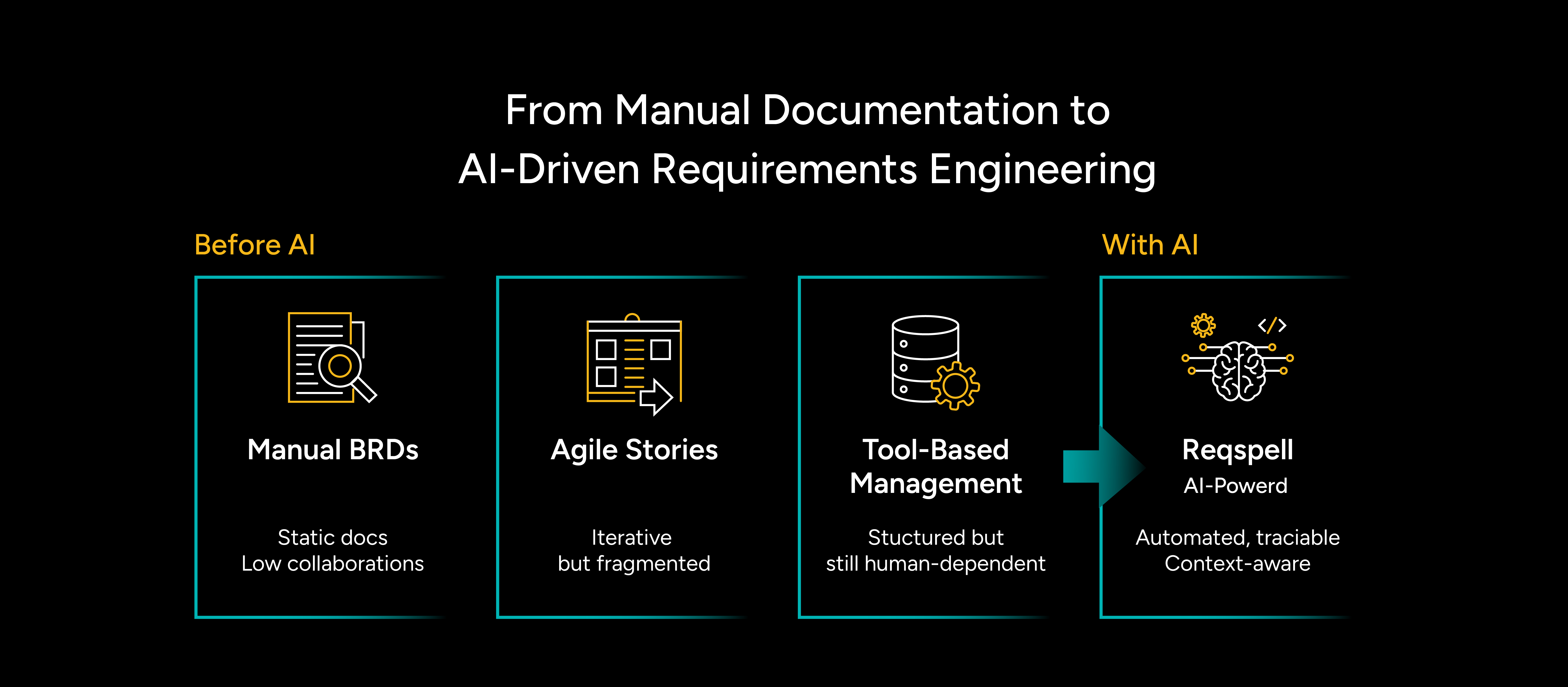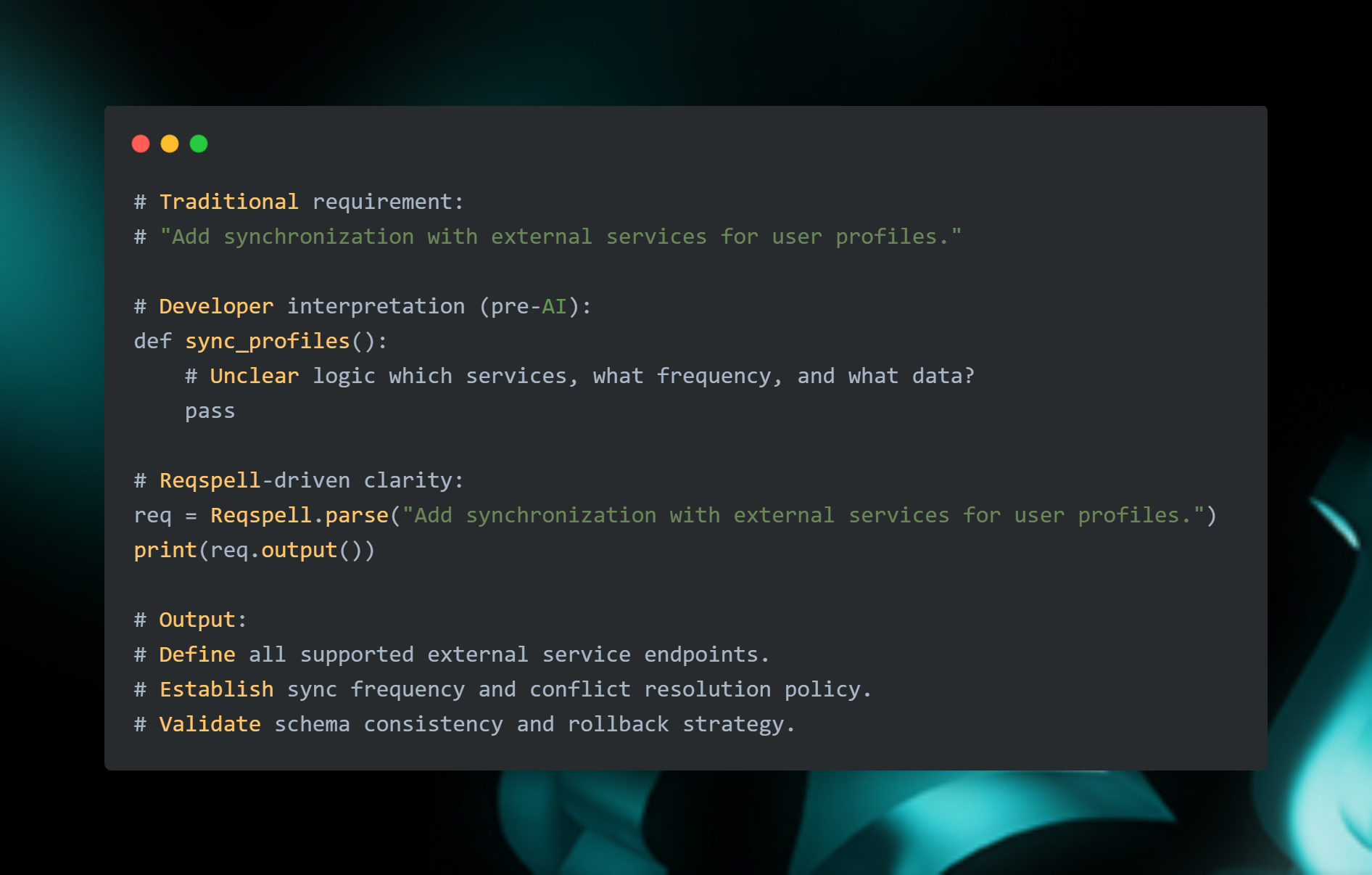December 12, 2025
Software development has always revolved around one core principle building the right thing before building it right. Yet, for decades, the “right thing” has often been lost in translation between business goals and technical execution.
As a developer, I’ve seen how easily clarity dissolves when requirements are reduced to static documents, email threads, or vague Jira tickets. What was intended as structured guidance frequently becomes fragmented, inconsistent, and prone to misinterpretation.
Requirements engineering, once thought of as an administrative layer, is now at the center of software efficiency. And its transformation, especially with AI-driven tools like ReqSpell, is reshaping how engineering teams move from ambiguity to actionable precision.
From Manual Documentation to Disconnected Workflows
Historically, requirements engineering was a documentation exercise. Analysts collected stakeholder inputs, wrote detailed Business Requirement Documents (BRDs), and circulated them across teams.
The intent was noble: to create a single source of truth. But in practice, it rarely worked that way.
Developers received long-form documents filled with functional statements, most of which lacked technical depth. Testers interpreted the same text differently. Business teams added clarifications for mid-cycle. And by the time a feature was ready for QA, the requirement often no longer reflected reality.
Every project carried an invisible cost: the cost of assumption.
We didn’t fail because of poor coding; we failed because the starting point was unclear.

Agile’s Promise, and Its Limitations
When Agile methodologies emerged, they promised flexibility and collaboration. Documentation was replaced with user stories, backlogs, and continuous stakeholder interaction. In theory, this made requirements more adaptive and responsive.
In practice, however, Agile often shifted the problem rather than solving it.
Requirements became shorter but not necessarily clearer. Phrases like “As a user, I want to…” gave teams direction but not definition. Without detailed acceptance criteria or contextual mapping, developers still relied heavily on conversations, assumptions, and tribal knowledge.
As projects scaled, so did complexity. Dependencies multiplied, modules intertwined, and “user stories” turned into disconnected fragments of intent. Agile accelerated delivery, but it also accelerated ambiguity.
.png)
The Real Challenge: Translating Human Intent into Engineering Logic
At its core, requirements engineering is a translation problem.
Stakeholders speak in business terms, revenue, user engagement, and market differentiation. Developers think in systems, APIs, schemas, and logic flows. Bridging this gap requires not just communication, but structured interpretation.
For example, a business statement like:
“The platform should ensure secure login and easy account recovery.”
…translates into multiple technical questions:
- What authentication mechanism are we using?
- Does “secure” imply MFA, OAuth, or token-based authentication?
- What’s the protocol for password resets,email, SMS, or app-based?
- How should session management be handled in post-login?
Without a shared context model, every team member interprets this differently. That’s where traditional methods fall short; they document intent but fail to enforce consistency.
The Shift Toward Intelligent Requirements
AI has introduced a paradigm shift in how requirements are captured, analyzed, and executed. Rather than relying solely on human interpretation, systems like Reqspell apply structured intelligence to the process, identifying patterns, dependencies, and ambiguities in real time.
From a developer’s perspective, this evolution is transformative.
Reqspell doesn’t just automate documentation; it contextualizes requirements. It analyzes natural language inputs, Jira tickets, user stories, feature briefs, and transforms them into structured, testable, and traceable engineering statements.
This means that instead of decoding vague directives, developers now receive machine-validated clarity.
Here’s an example:
The output isn’t just a summary, it’s a structured guide that anticipates developer questions before they arise.

Reqspell’s Role: Structuring Intelligence at the Requirement Layer
Reqspell acts as a cognitive bridge between product intent and technical execution.
Instead of static documentation, it creates dynamic, machine-readable blueprints that align with both business and engineering expectations.
1. Contextual Understanding
Reqspell identifies logical dependencies within and across requirements. For instance, modifying a login flow might impact authentication APIs, database schemas, and security policies. The system automatically highlights these linkages, minimizing the risk of regression errors.
2. Consistency and Standardization
By enforcing a structured format, Reqspell ensures every requirement adheres to the same interpretive model. This eliminates the inconsistencies often introduced by multiple authors or teams working in silos.
3. Integrated Traceability
Traditional traceability matrices are tedious to maintain. Reqspell automates this by maintaining real-time linkage between requirements, associated code components, and corresponding test cases.
For example:
The system doesn’t just record impact, it guides next actions, helping developers focus on implementation rather than detective work.

Elevating Collaboration Across Roles
In most organizations, the communication chain between business analysts, developers, and testers is long and nonlinear. Misinterpretations compound across teams.
Reqspell streamlines this by ensuring everyone interacts with the same structured version of truth.
- Product Managers define intent in plain language.
- Developers view system-level requirements mapped to technical scope.
- Test Engineers see auto-linked validation paths and acceptance criteria.
This multidimensional transparency means alignment happens by design, not by meetings.
Reducing Ambiguity at Scale
The complexity of enterprise systems makes ambiguity inevitable.
But AI changes the equation, by continuously learning from requirement histories, Reqspell identifies linguistic patterns that historically led to confusion and flags them during creation.
Phrases like “as needed,” “frequently,” or “easy to use,” once acceptable in documentation, are now automatically flagged for clarification. This proactive precision enhances engineering efficiency and safeguards quality at scale.
From Documentation to Intelligence: A New Paradigm
Reqspell isn’t an incremental improvement; it’s a fundamental rethinking of what requirements represent.
Instead of serving static documentation, they evolved into dynamic, interconnected data models.
Each requirement becomes:
- Traceable through the entire SDLC
- Automatically validated for consistency
- Contextually mapped to dependent modules and APIs
- Readable by both humans and machines
This convergence ensures that development velocity is no longer at odds with accuracy.
A Developer’s Perspective on the Shift
For developers, the real benefit of Reqspell isn’t just automation, it’s liberation from ambiguity.
The cognitive overhead of interpreting unclear requirements is one of the most under-discussed productivity drains in modern engineering.
When requirements are intelligent, traceable, and validated, developers can focus entirely on building. Code reviews become smoother. QA cycles become shorter. Most importantly, engineering effort aligns directly with product vision, not assumptions.
The Road Ahead: AI as a Co-Pilot for Requirements
As AI becomes intrinsic to every layer of software development, engineering requirements will continue evolving from descriptive to predictive. Reqspell represents the first major step in that direction, not only interpreting what’s written, but also anticipating what’s missing.
In the near future, intelligent systems will not only validate requirements but also generate architectural implications, recommend test coverage, and align sprint objectives dynamically.
The role of the developer will evolve from interpreter to implementer, building solutions from clarity, not conjecture.
Conclusion: Engineering with Precision, Powered by Clarity
The evolution of engineering requirements has come full circle, from static documentation to living intelligence.
What was once an exercise in documentation has now become a discipline of structured understanding.
Reqspell embodies this transition by transforming how teams define, trace, and execute intent. It integrates AI-driven context with engineering rigor, bridging the divide between vision and execution.
In an era where speed and precision determine success, clarity isn’t optional, it’s foundational. And with Reqspell, clarity is finally engineered into the process itself.


.png)






.png)
.png)